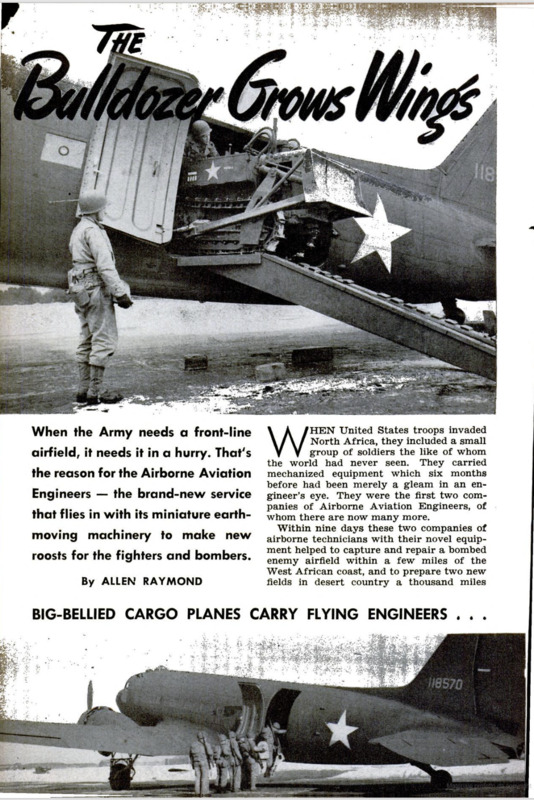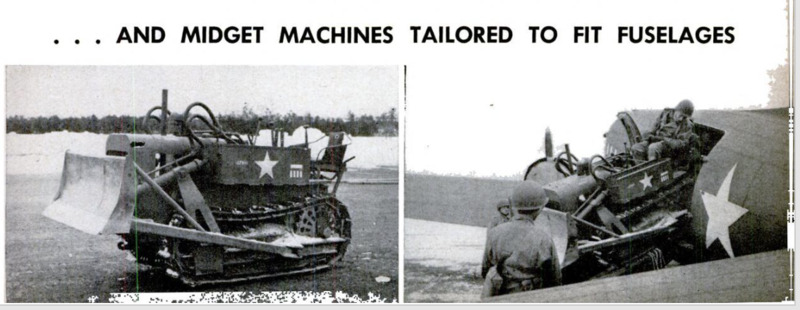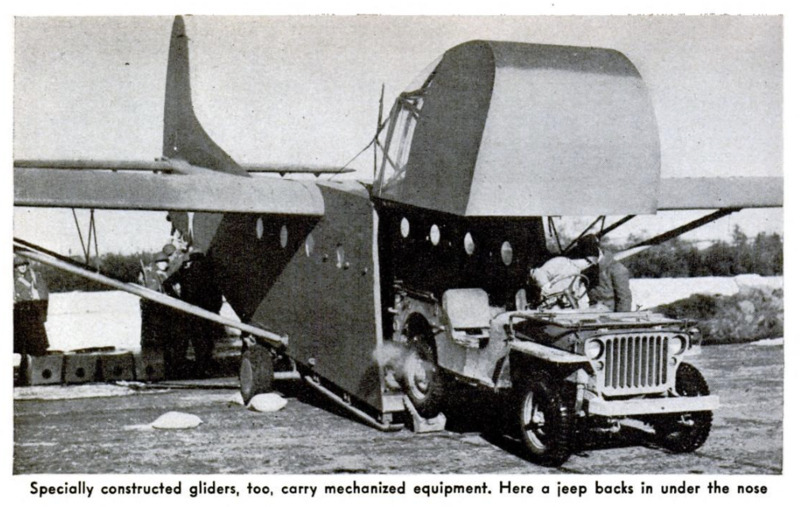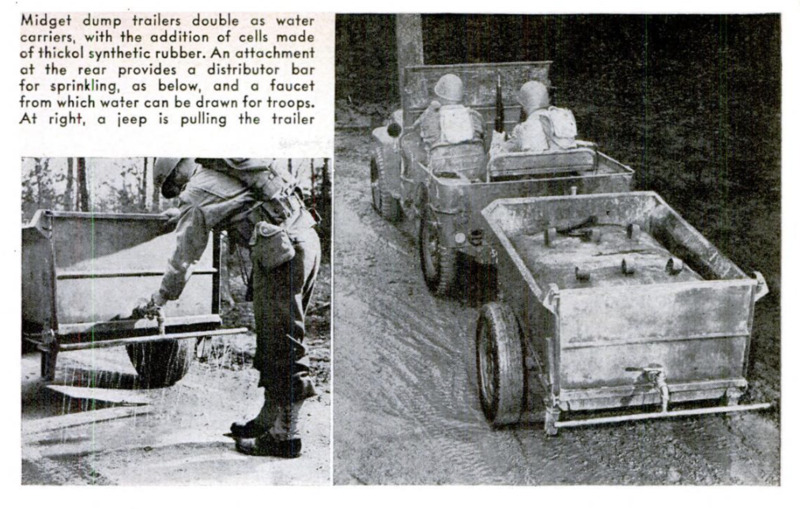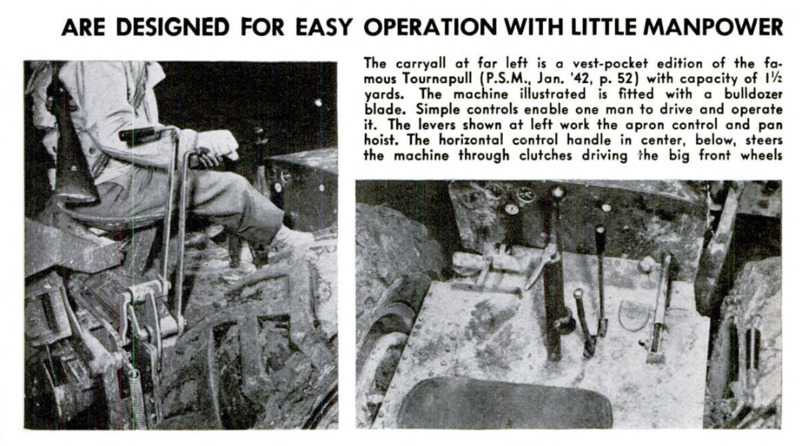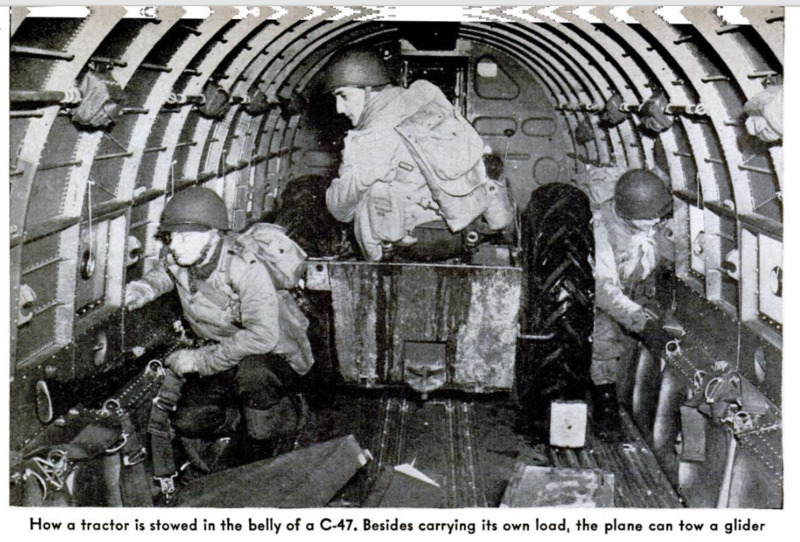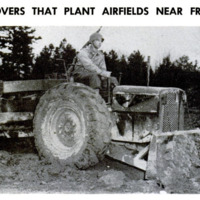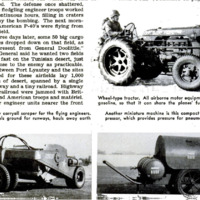-
Title (Dublin Core)
-
The Bulldozer Grows Wings
-
Article Title and/or Image Caption (Dublin Core)
-
The Bulldozer Grows Wings
-
extracted text (Extract Text)
-
WHEN United States troops invaded
North Africa, they included a small
group of soldiers the like of whom
the world had never seen. They carried
mechanized equipment which six months
before had been merely a gleam in an en-
gineer's eye. They were the first two com-
panies of Airborne Aviation Engineers, of
‘Whom there are now many more.
Within nine days these two companies of
airborne technicians with their novel equip-
ment helped to capture and repair a bombed
enemy airfield within a few miles of the
West African coast, and to prepare two new
fields in desert country a thousand miles
‘eastward on the Tunisian battlefront, along
Which our Flying Fortresses and fighter
planes went roaring into action.
The organization of these airborne avia-
tion engineers was a distinctly American
contribution to the art of warfare. They
were the brain child of Brigadier General
Stuart C. Godfrey, Alr Engineer, Directorate
of Base Services, Army Air Forces, The Gen-
eral, a graduate of West Point in 1009, com-
manded an engineer regiment in France in
World War I; and between military assign-
‘ments in peacetime wrestled with engineer-
ing Jobs on rivers and harbors {rom Panama
to Muscle Shoals. Aside from his engineer-
ing talents, he writes verse; he wrote the
Iyrics for the Army Engineers’ Fight Song,
for which his wife composed the music.
In the spring of 1042, the General was
‘pondering the dictum of General Henry H.
(“Hap”) Arnold, that air power is u three-
legged stool, of Which the three legs are
pilots, planes, and airfields. Without the
flelds, pilots and planes cannot operate. The.
effective range of bombers and fighters is
not entirely determined by their flying speed
and fuel capacity, but by the proximity of
thelr bases to the enemy.
In global warfare, and particularly In
island-to-island warfare in the Southwest
Pacific, the General ruminated, aviation en-
gineers should not be confined to the ground,
but be able to fly up fast to distant fronts
for construction, repair, and maintenance of
flelds; just us fast ax airborne infantry or
paratroops could seize a base for them, or
even faster In some situntions. The major
obstacle to this engineer's dream was the
size of all standard types of earthmoving
‘machinery. It was far too large to be flown
in airplanes. The major problem, therefore,
was to design such machinery on a much
smaller scale.
On May 14, 1042, the General wrote a let-
ter to the Chief of Engineers, U.S.A. asking
for help in implementing this idea. On June
8 a conference was held in hia office in
‘Washington, at which two men were as-
signed to develop plans for the new equip-
ment, and a table of organization for air-
borne engineer battalions who could use it.
These two men were Lieutenant Colonel
Elsworth Davis of the Engineer Board, the
Army Engineers research organization, and
Lieutenant Colonel H. G. Woodbury of the
Aviation Engineers.
With the enthusiastic help of manufactur-
ers scattered throughout the country, earth
‘moving machinery tailored to airplane meas.
‘urements was designed, built, and placed in
the hands of troops within four months.
The C47 transport plane was then the only
available plane for carrying such oquip-
ment. A capacious cargo carrier, this plane
has a side door about seven feet wide by five
feet high, and had already proved useful in
carrying paratroops or nirborne infantry
with Jeeps or other heavy equipment.
Small-uize bulldozers, scrapers, tractors,
graders, rollers, and asphalt heaters and dis-
tributors were bull to the limitations of that
airplane.
‘The bulldozer, as Its name implies, is an
instrument to push aside obstacles such as
dirt, stones, and trees, and to level the land
over which it travels. It consists of a tractor
with a blade like that of a mowplow. A
standard bulldozer, such as is used by Army.
engineers in general, weighs about 10 ton
and has a 10-foot blade. The new miniature
bulldozer, adapted for America’s airborne
aviation engineers from a model used by the
U. 8. Forestry Service, welghs only about
21; tons, has a blade slightly more than six
feet lon, and can easily be driven on a
ramp through the door of a cargo plane.
‘Standard bulldozers have commonly used
Diesel engines for fuel economy. The alr-
borne models are powered by gasoline en-
ines, so that the fuel will be the same as in
other Army mechanized equipment.
A new carryall scraper was designed,
which Is & combination blade and dump
cart, used to level elevations in any terrain
where a runway is being built, and to fil
In depressions. Standard scrapers for the
grounding engineers have been of eight-
yard capacity. They can dig up and haul
away eight cublc yards of earth. The min-
lature scrapers for the airborne engineers
are of 1 3/4 -yards capacity. Other new equip-
ment included a grader small enough to be
pulled by a jeep, and an asphalt heater little
larger than some office desks. There was
also a new-type roller, just a hollow metal
drum to be filled with water or sand on the
scene of operations, Empty, this drum
weighs about a ton. Filled, it weighs more
than three tons. A novelty in this Army-
designed roller is its attachable “sheep’s-
foot” studs. These studs can be fitted to
the roller on metal bands; as the roller re-
volves, they can tamp and compact an eight-
inch layer of earth. Specially designed water
purifiers and lighting units were also pro-
duced.
The first table of organization for the air-
borne aviation engineers was submitted by
Lieutenant Colonel Woodbury on July 9,
1942, and on August 18 the Adjutant Gen-
eral directed the First Air Force to activate
the First Provisional Airborne Engineer
Aviation Battalion at Westover Field, Mass.,
with a cadre, or skeleton organization, com-
posed of 100 volunteers from existing avia-
tion-engineer units. To help train this com-
. mand, and to carry equipment for it, the
Troop Carrier Command provided several
C-47 planes.
On August 29, Major General Jimmie Doo-
little, who was to command American air
forces in the initial African invasion, said
that if these new-type engineers could be
prepared in time he wanted them. A com-
mitment was made to have two companies
ready. As fast as the equipment rolled from
the factory assembly lines, it was flown to
Westover Field, and on October 8, just four
months from the initial planning conference
in General Godfrey's office, these two com-
panies, completely trained and equipped,
left Westover Field for an embarkation port.
On November 8, the first company of Air-
borne Aviation Engineers were part of a
combat team which landed on a hostile
coast near Port Lyautey, Morocco. They
rolled their toy equipment inland, and with-
in a few hours suffered their first casualties
while helping to storm an inland airfield
which U. S. Navy flyers had rendered useless
with their bombs, but which was still de-
fended. The defense once shattered, |
these fledgling engineer troops worked
16 continuous hours, filling in craters |
left by the bombing. The next morn- |
ing American P-40's were flying from |
the field. |
Three days later, some 50 big cargo "
planes dropped down on that field, as k
“a present from General Doolittle.” ;
The General said he wanted two fields |
built fast on the Tunisian desert, just ; of
as close to the enemy as practicable. \
Between Port Lyautey and the sites )
picked for these airfields lay 1,000 |
miles of desert, spanned by a single |
highway and a tiny railroad. Highway |
and railroad were jammed with Brit-
ish and American troops and matériel.
Other engineer units nearer the front
were wrestling with other jobs. The new
airborne aviation engineers flew the 1,000
miles to the front, and within three days
had a field ready for bomber operation. On
the fourth day they completed a field for
our fighter planes.
It takes a run-
way about a mile long, of level, hard-packed
earth, steel mats, or asphalt to make an
effective landing strip for our Flying For-
tresses. One somewhat smaller will serve our
fighter planes. On one of these jobs, the air-
borne engineers had some help from Arab
labor, paid in American cigarettes,
These two fields were a source of grief
to the Nazi forces in Tunisia, and to con-
voys coming up to supply them. Then came
Rommel’s short-lived attack, which over-
ran one field temporarily. When American
troops recaptured the field, they got a
chuckle. Our Aviation Engineers had been
forced to withdraw too fast to destroy all
their heavy equipment, but had camouflaged
it so well that the Nazi forces failed to
find it.
As now organized, each Airborne Avia-
tion Engineer battalion consists of a head-
quarters company and three construction
companies, with a strength of about 600 men
and officers. A lieutenant colonel commands
each battalion, and with him are seven staff
officers.
Each construction company has seven
tractors, three scrapers, two graders, a roll-
er, five jeeps, two trucks, and so much other
miscellaneous equipment that it takes be-
tween 15 and 20 of the big C-47 planes to
transport it. All the equipment is adapt-
able for use in gliders. Inasmuch as the en-
gineers must fight as well as work, they are
loaded with fire power: rifles, tommy guns,
pistols, carbines, and .50 caliber machine
guns with which to fight off dive-bombing
cad machine-gunning attacks from the air.
It takes five months to train one of these
companies; aside from their technical train-
ing, emphasis is placed on physical tough-
ening.
Obviously, the light equipment carried by
the airborne aviation engineers is not suited
to carry the main load of building the Army's
airfields. The standard-size, heavy equip-
ment being used by our aviation engineer
battalions around the world will always do
the bulk of the work. But the airborne unit
is now of proved value as a weapon of op-
portunity, adding flexibility and speed to
our forces in some situations. It bears about
the same relation to the heavy equipment
as does a light, quickly thrown ponton
bridge to the heavy, fixed bridge which is to
replace the ponton bridge later.
The airborne units will not be charged
with building or repairing elaborate ground
installations, or attempting elaborate cam-
ouflage work, though they are schooled in
rudimentary camouflage for self-protection.
Their job is to provide quickly the minimum
landing facilities necessary to allow planes
to operate.
In the case of captured fields, they may
fill bomb craters; neutralize contaminated
areas; help combat engineers remove booby
traps, mine fields, and other obstacles; con-
struct dispersal areas, and repair access
roads and all kinds of utilities. The portable
steel landing mats which are now being
shipped by the millions of square feet to our
airfields all over the world are too bulky
for much use by these airborne aviation
engineers, except in small quantities for
patching and special jobs.
Essentially, these new troops are pioneers,
adding to the speed of air war, the speediest
war there is. Their ranks are open for tough,
skilled men who are looking for plenty of
action,
-
Language (Dublin Core)
-
eng
-
Date Issued (Dublin Core)
-
1943-06
-
pages (Bibliographic Ontology)
-
66-70, 212, 214
-
Rights (Dublin Core)
-
Public Domain (Google digitized)
-
Archived by (Dublin Core)
-
Matteo Ridolfi
-
Alberto Bordignon (Supervisor)
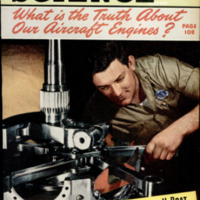 Popular Science Monthly, v. 142, n. 6, 1943
Popular Science Monthly, v. 142, n. 6, 1943

